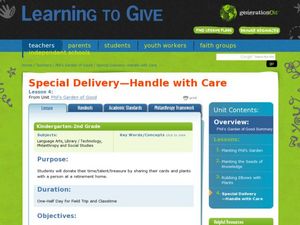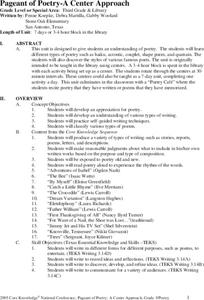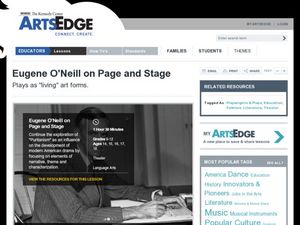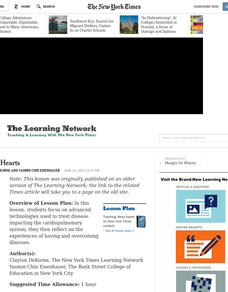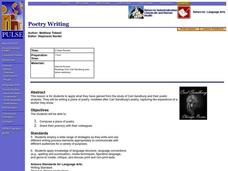Curated OER
Does Clear Water mean Healthy Water?
Learners test their local aquatic site to determine its water clarity. They collect a water sample and measure its turbidity using a sensor, then they repeat the experiment to obtain a second turbidity reading to find the average value.
Curated OER
Old Bear
Students explore different aspects of nature through a bear. In this lesson about Old Bear, students understand nature and how it all works together. Students read the story and then participate in answering discussion questions about...
Curated OER
Story-Hour Kit
Students explore four picture books. In this early childhood lesson, students are read the books, discuss them, and then complete extension activities. These include writing and illustrating their own experiences, practice with emotions,...
Curated OER
Phil's Garden of Good
Learners read "The Rainbow Fish" and discuss how the fish benefited by giving others. In this sharing lesson, students prepare plants and letters for senior citizens. Learners present their letters and plants at a visit to a senior...
Curated OER
A Center Approach to Poetry
Students experience the different types of poetry in order to classify them. In this poetry lesson, students discover the multiple types of poetry while reading in the library. Ultimately, the students create their own poetry and share...
Curated OER
How Does Your Garden Grow?
Students read The Garden by Arnold Lobel, plant seeds to discover what makes them grow, and record their observations in their journals.
Curated OER
Introducing Nonfiction
Students are introduced to nonfiction text. In this five esson unti, students explore nonfiction as a genre. They identify the components and text structure of text structure of nonfiction text. Students read a nonfiction passage and...
Curated OER
Polar Express Lesson Plan
Young scholars develop a podcast as they retell the story of The Polar Express. In this early childhood lesson plan, students experience technology by creating a podcast. Young scholars also create illustrations to be scanned for the...
Curated OER
No Regrets: a Poetry Analysis
Young scholars read a poem and use the TPCASTT strategy for analysis. In this poetry analysis lesson, students journal about their future goals and read John Updike's "Ex-Basketball Player." Young scholars discuss the purpose of the poem...
Curated OER
Eugene O'Neill on Page and Stage
Students investigate the life and works of Eugene O'Neill. In this American theater lesson, students read biographical information about O'Neill and review Long Day's Journey into Night. Students then analyze the play in order to deliver...
Curated OER
Leap! Frog!
Students write a report stating facts and opinions based on frogs. Investigate and understand the changes that take place during the life cycle of a frog. Respond to language, meanings and ideas in different texts, relating them to...
Curated OER
Variable Skies
Learners examine factors which affect a vortex and create model tornadoes. They identify variables, pose a testable question, and perform an experiment using the scientific method. After they collect their data, students write a complete...
Curated OER
Healthy Hearts
Students focus on advanced technologies used to treat disease impacting the cardiopulmonary system; they then reflect on the experiences of having and overcoming illnesses.
Curated OER
Talking Trash - Online Message Boards
Students consider their own experiences with online message boards and chat rooms, discover how teens are using the Web to talk about people in their lives, discuss the issues surrounding online conversations.
Curated OER
Musical Imagery
Learners experience musical imagery. They link this musical concept to literary imagery to gain an understanding of the use of imagery in both genres. After listening to a varriety of sounds, students will compose and perform a melody.
Curated OER
A Valid Conclusion? Testing and Reporting on Hypotheses Using the Scientific Method
Students explore importance of accuracy in reporting, focusing particularly on articles documenting scientific discoveries, and practice scientific method by conducting experiments to test and report on scientific hypotheses.
Curated OER
Would You Believe Your Eyes?
Learners study the parts and functions of the human eye. They create dodecagons which are twelve-sided figures with twelve equal angles and share these with the class so that each student can begin to see how many different illusions can...
Curated OER
From America, With Love
Students research the experiences of specific immigrant groups in the United States. Letters are written from imaginary immigrants to relatives in their countries of origin, including historically accurate details.
Curated OER
Reluctant Immigrants
Students examine the reasons why people from Nigeria have immigrated to the United States. They read and describe a refugee's experience leaving her home country. They view a video clip as well.
Curated OER
Baseball Memories
Students act as historians by, first, reading and analyzing oral histories of professional baseball players to become familiar with baseball figures. Then, they proceed to interview family members, relatives, or neighbors who have...
Curated OER
Immigration and Photography: The Case of Lewis Hine
Students are introduced to the characteristics of documentary photography. Individually, they cut out a paper frame and view their classroom through the "lens" and at different angles. After veiwing photographs, they practice...
Curated OER
Postcards From Mars
Fifth graders research and explore what life would be like for human colonists on Mars. They explore various websites, read and discuss newspaper articles, develop a chart of the hardships and conditions that would be faced by colonists...
Curated OER
Poetry Writing
Students compose a piece of poetry modeled after the poetry of Carl Sandburg and share their poem(s) with their colleagues. They use a cluster diagram to organize their thoughts and brainstorm their ideas.
Curated OER
Solids, Liquids and Gases
Students are introduced to the various states of matter. After watching a video, they discover how to compare the three states using its shape and volume. In groups, they participate in an experiment with solids, liquids and gases and...





